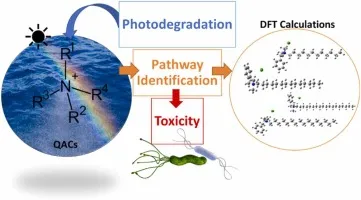Quaternary ammonium compounds (QACs) are commonly used in many products, such as disinfectants, detergents and personal care products. However, their widespread use has led to their ubiquitous presence in the environment, posing a potential risk to human and environmental health. Several methods, including direct and indirect photodegradation, have been explored to remove QACs such as benzylalkyldimethyl ammonium compounds (BACs) and alkyltrimethyl ammonium compounds (ATMACs) from the environment. Hence, in this research, a systematic review of the literature was conducted using PRISMA (Preferred Reporting Items for Systematic Reviews and Meta-Analysis) method to understand the fate of these QACs during direct and indirect photodegradation in UV/H2O2, UV/PS, UV/PS/Cu2+, UV/chlorine, VUV/UV/chlorine, O3/UV and UV/O3/TiO2 systems which produce highly reactive radicals that rapidly react with the QACs, leading to their degradation. As a result of photodegradation, several transformation products (TPs) of QACs are formed, which can pose a greater risk to the environment and human health than the parent QACs. Only limited research in this area has been conducted with fewer QACs. Hence, quantum mechanical calculations such as density functional theory (DFT)-based computational calculations using Gaussian09 software package were used here to explain better the photo-resistant nature of a specific type of QACs, such as BACs C12–18 and ATMACs C12, C14, C18, and their transformation pathways, providing insights into active sites participating in the phototransformation. Recognizing that different advanced oxidation processes (AOPs) come with pros and cons in the elimination of QACs, this review also highlighted the importance of implementing each AOP concerning the formation of toxic transformation products and electrical energy per order (EEO), especially when QACs coexist with other emerging contaminants (ECs).
